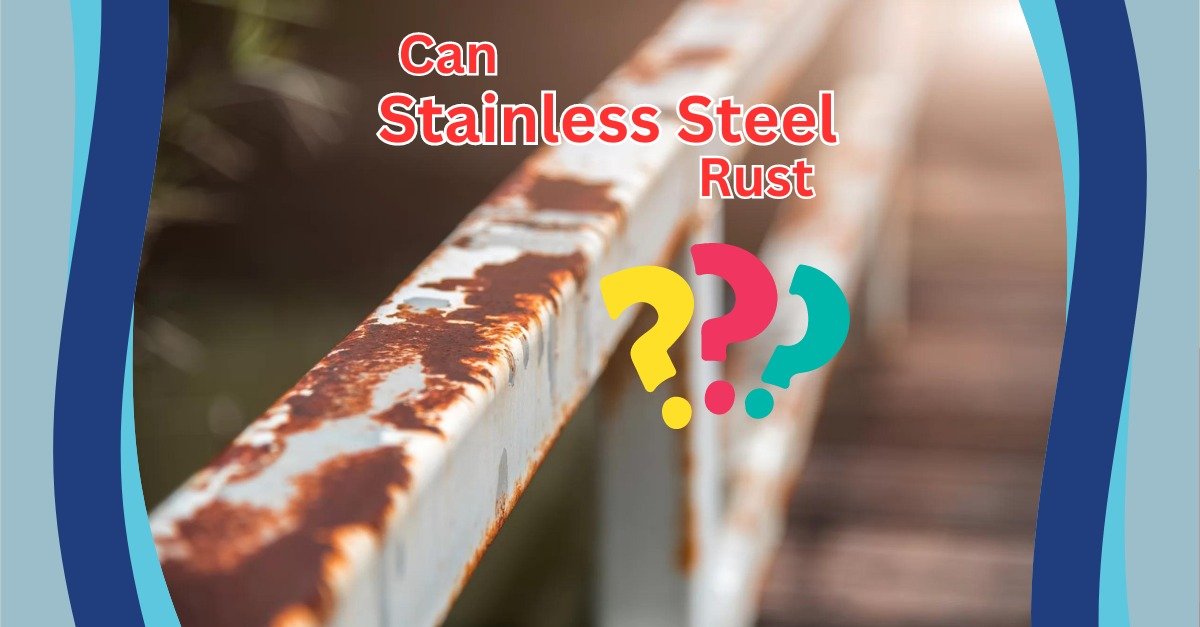When you hear about stainless steel, the first thought that often comes to mind is its impressive resistance to rust and corrosion. However, can stainless steel rust? This question has intrigued many, and the truth is a bit more nuanced than a simple yes or no. In this post, we’ll explore the nature of stainless steel, why it can rust under certain conditions, and how to properly maintain it.
What is Stainless Steel?
Stainless steel is a versatile alloy composed primarily of iron, chromium, and a small percentage of other metals, such as nickel and molybdenum. The key ingredient in stainless steel is chromium, which typically constitutes at least 10.5% of the alloy. This essential component plays a crucial role in providing stainless steel with its unique properties, particularly its remarkable resistance to corrosion and rust.
When exposed to air, chromium reacts with oxygen to form a thin, invisible layer of chromium oxide on the surface of the metal. This protective layer acts as a barrier, shielding the underlying iron from moisture and oxygen—two primary elements responsible for rust formation. This layer is self-repairing, meaning that if it gets damaged, it can reform as long as there is enough chromium present.
Despite its name, the term “stainless” can be misleading. While stainless steel is far more resistant to rust and corrosion than regular carbon steel, it is not entirely immune. Under specific conditions, such as prolonged exposure to saltwater or harsh chemicals, stainless steel can develop corrosion, which is why proper care and maintenance are essential for preserving its integrity and appearance over time.
How Does Rust Form?
Rust is the result of a chemical reaction between iron, moisture, and oxygen. This process, known as oxidation, can occur in various environments. For standard steel, rust typically appears as a reddish-brown flaking or pitting on the surface. In stainless steel, the chromium content works to protect the iron within the alloy, making it much more resistant to rust. However, under certain conditions, stainless steel can still corrode. If the protective chromium oxide layer is damaged due to physical wear, exposure to harsh chemicals, or prolonged contact with moisture, the underlying iron can react with oxygen and form rust.
Factors Contributing to Rust on Stainless Steel
There are several factors that can lead to rust on stainless steel, despite its reputation. Environmental factors play a significant role. Stainless steel can rust in harsh environments, such as coastal areas with high salt concentrations or industrial areas with corrosive chemicals in the air. Physical damage can also contribute to rusting. Scratches or abrasions can disrupt the protective chromium oxide layer, allowing moisture to penetrate and lead to rust. Moreover, poor maintenance can exacerbate the issue. Neglecting to clean stainless steel surfaces regularly can result in the accumulation of contaminants, such as dirt, grease, and salts, which can compromise its protective layer. Lastly, the quality of stainless steel itself matters. Not all stainless steel is created equal, and different grades offer varying levels of corrosion resistance. For example, 316 stainless steel contains molybdenum, which enhances its resistance to rust in chloride-rich environments.
Understanding Different Grades of Stainless Steel
Understanding the different grades of stainless steel can help you choose the right type for your needs. One of the most widely used grades is 304 stainless steel, known for its excellent corrosion resistance and good formability. It is suitable for a variety of applications but may not perform well in coastal environments. On the other hand, 316 stainless steel is often referred to as marine-grade stainless steel due to its enhanced resistance to corrosion, particularly in saltwater environments. This makes it an excellent choice for outdoor use. There is also 430 stainless steel, which, although less expensive and having good resistance to corrosion, is not as durable as 304 or 316 and is more prone to rust in harsh conditions. Choosing the right type of stainless steel for your project can make a significant difference in how well it performs over time.
Preventing Rust on Stainless Steel
Preventing rust on stainless steel is crucial for maintaining its durability and aesthetic appeal. Regular cleaning is the first line of defense against corrosion. It is essential to clean stainless steel surfaces frequently with warm water and a mild soap solution. This practice helps remove dirt, oils, and other contaminants that can compromise the protective layer. After cleaning, always dry the surface thoroughly to eliminate moisture accumulation, which can lead to rust formation.
It is also wise to avoid harsh chemicals when cleaning. Chlorine-based cleaners and abrasive detergents can damage the protective chromium oxide layer, making the stainless steel more susceptible to rust. Instead, opt for gentle cleaners that are specifically formulated for stainless steel.
Regular inspections for physical damage are equally important. Check for scratches, abrasions, or any signs of wear that may expose the underlying metal. If you find any damage, consider polishing the affected area to restore the protective layer. In particularly corrosive environments, such as coastal areas or industrial settings, applying a protective coating designed for stainless steel can further enhance its resistance to rust and corrosion, ensuring it remains in top condition for years to come.
Recognizing Early Signs of Rust
Recognizing the early signs of rust on stainless steel is vital for taking corrective action before the problem escalates. Being proactive can save you time, money, and the integrity of your stainless steel items. One of the first signs to watch for is discoloration. If you notice any changes in color, such as the appearance of brown or red spots, it may indicate the beginning of rust formation. These discolorations are often the result of oxidation and can be the first signal that the protective layer has been compromised.
Additionally, inspect the surface for small pits or flakes, which can suggest that rust is forming beneath the surface. These imperfections are often the result of corrosion starting to take hold, and catching them early can prevent more extensive damage. Another important indicator is the texture of the surface. If you feel roughness or bumps, it may signify that corrosion is occurring.
Promptly addressing these early warning signs is essential. If you notice any of these issues, take immediate action to clean the affected area and restore the protective layer. Regular inspections and quick responses can significantly prolong the life of your stainless steel items and maintain their appearance.
Proper Care and Maintenance of Stainless Steel
Proper care and maintenance can prolong the life of your stainless steel items. For basic cleaning, you can use a mixture of warm water and a few drops of mild dish soap. Wiping the surface with a soft cloth or sponge can keep it clean. For tougher stains, making a paste of baking soda and water can be effective. Apply it to the stain, let it sit for a few minutes, and then scrub gently with a soft cloth. To restore shine, you can use a stainless steel cleaner or a solution of vinegar and olive oil. Applying this with a soft cloth and buffing to a shine can enhance its appearance. It is essential to avoid using steel wool or abrasive pads, as they can scratch and damage the surface.
Comparing Stainless Steel with Other Metals
When considering materials for a project, it is essential to compare stainless steel with other metals. While aluminum, carbon steel, and even bronze have their benefits, they may not offer the same level of corrosion resistance. Aluminum is lightweight and resistant to corrosion, but it is less durable than stainless steel and can corrode in marine environments. Carbon steel offers high strength but is highly susceptible to rust without protective coatings. Bronze, known for its corrosion resistance in marine environments, is often more expensive than stainless steel. Overall, stainless steel remains a top choice for a variety of applications due to its balance of durability, aesthetic appeal, and resistance to rust.
Conclusion
In summary, while stainless steel is highly resistant to rust, it is not entirely immune. Understanding the properties of stainless steel, the reasons it can rust, and the best practices for maintenance will help ensure that your stainless steel items remain in top condition. By following proper care techniques and choosing the right grade for your needs, you can enjoy the many benefits of stainless steel without the worry of rust.
FAQ about Stainless Steel Rust
Can all stainless steel rust?
Yes, while stainless steel is resistant to rust, it can still corrode under certain conditions.
How do I remove rust from stainless steel?
You can use a mixture of baking soda and water to scrub the rust spots gently. You may also use commercial stainless steel cleaners.
Is it safe to use rusty stainless steel?
While minor rust may not pose a significant health risk, it is best to remove it before using the item, especially for food preparation.
What is the best way to clean stainless steel?
Regular cleaning with warm soapy water and drying thoroughly can prevent moisture accumulation.
How long does stainless steel last before rusting?
With proper maintenance, stainless steel can last for decades without rusting, but environmental factors play a significant role.

Evelyn White is an experienced content writer with a background in lifestyle, trends, and practical advice. With several years of writing across digital platforms, she specializes in making everyday topics accessible, informative, and engaging. Her goal is to deliver trustworthy, reader-focused content that’s both useful and easy to understand.

